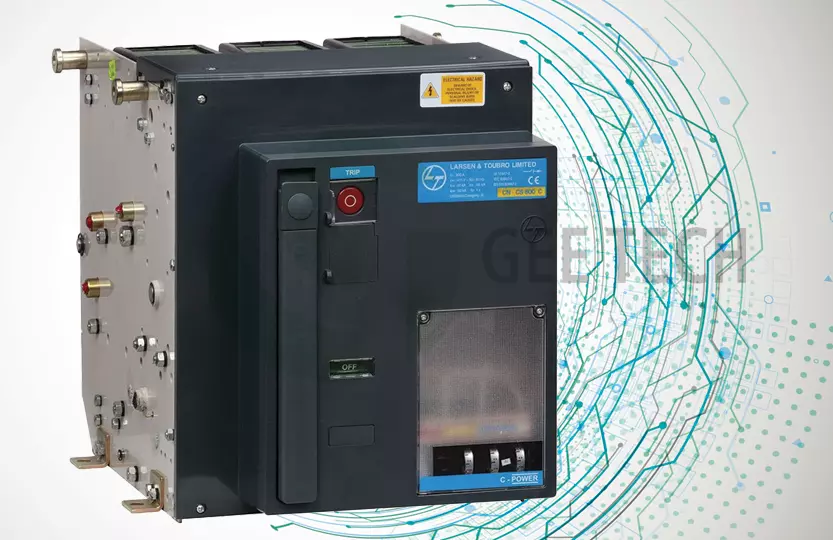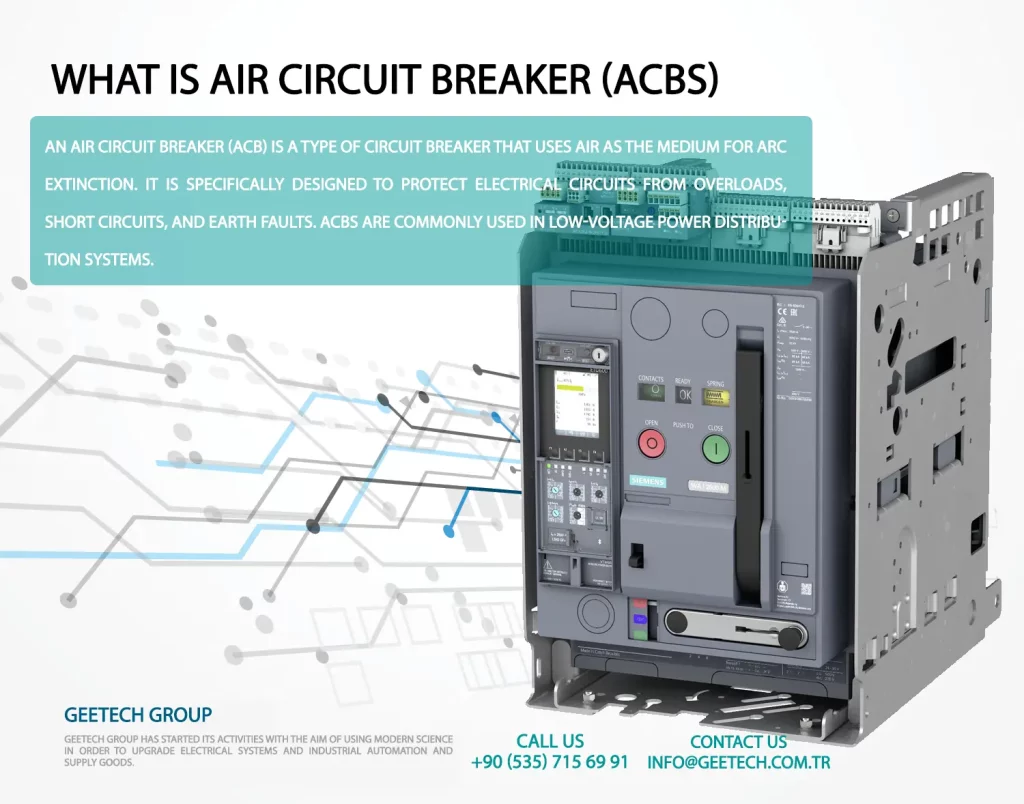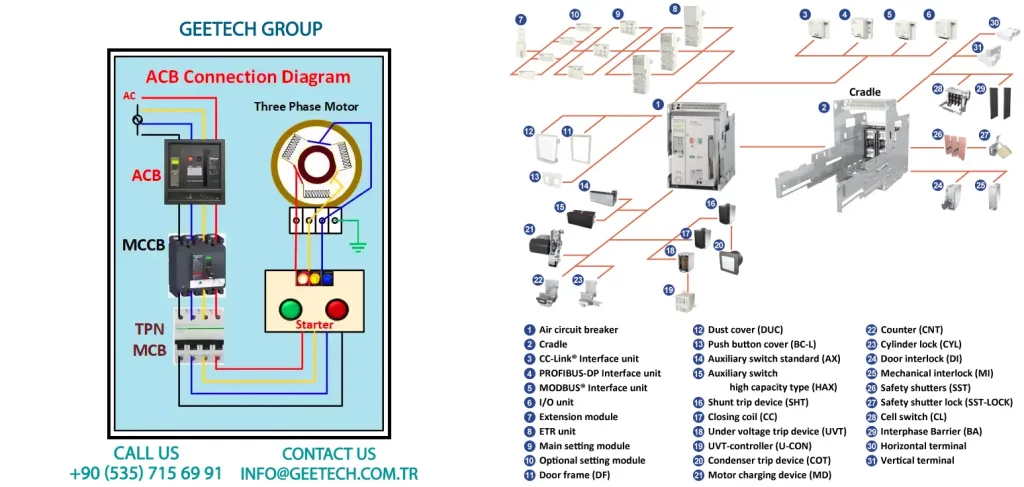
In this article, from the series of articles of GeeTech Group, we will learn about air circuit breakers and in this tutorial we will tell about air circuit breakers, their structure and types.
Table of contents of this article
- what is air circuit breaker
- how do air circuit breakers work
- air circuit breaker types
- air circuit breaker range
- air circuit breaker diagram
- air circuit breaker voltage range
- air circuit breaker ratings
- Schneider air circuit breaker
- Siemens air circuit breakers
- Abb air circuit breakers
- air circuit breaker price
What is Air Circuit Breaker (ACBs)
An Air Circuit Breaker (ACB) is a type of circuit breaker that uses air as the medium for arc extinction. It is specifically designed to protect electrical circuits from overloads, short circuits, and earth faults. ACBs are commonly used in low-voltage power distribution systems.

How Do Air Circuit Breakers Work
Working Principles Of Air Circuit Breakers
Arc Interruption Mechanism:
High current flows through an Air Circuit Breaker (ACB) during electrical malfunctions like short circuits or overloads. This causes the formation of an electric arc between the contacts of the circuit breaker. Surprisingly, even after tripping, the arc maintains a conductive path for current flow.
To tackle this issue, ACBs employ various arc quenching techniques. The most popular technique is the “blast effect” or “arc chute” principle. When the ACB detects the arc, it releases a high-pressure stream of air through specialized arc chutes. The rapid expansion of air in these chutes efficiently extinguishes the electric arc and allows the contacts to separate, thereby halting the current flow.
Magnetic and Thermal Tripping Mechanism:
Air Circuit Breaker incorporate both magnetic and thermal tripping mechanisms to identify abnormal current conditions and initiate circuit interruption. The magnetic tripping mechanism responds to short-circuit currents, while the thermal tripping mechanism detects prolonged overloads. Once the current surpasses a predetermined threshold, these tripping devices activate the opening mechanism, initiating the arc interruption process.
Air Circuit Breaker Types
Different types of ACBs (Air Circuit Breakers) are available for various applications, including different poles, capacities, installation types, and breaking capacities. Below are the details of the different types of ACBs.
1)Pole Type ACB:
A pole type ACB refers to the configuration of the circuit breaker in terms of the number of poles it has. In ACBs, a three-pole configuration represents a three-phase system, while a four-pole configuration represents a three-phase system with a neutral conductor.
Three Pole ACB: A three-pole ACB is designed to handle three-phase electrical systems, where each phase is connected to one of the three poles of the circuit breaker.
Four Pole ACB: A four-pole ACB is designed to handle three-phase electrical systems with a neutral conductor. It has an additional pole compared to the three-pole ACB, allowing for the protection and control of the neutral conductor in the circuit.
2)According to Current Capacity Type:
The current rating capacity of an ACB (Air Circuit Breaker) ranges from 400A to 6300A. Here are the details of the available current ratings:
- 400A
- 630A
- 800A
- 1000A
- 1200A
- 1600A
- 2000A
- 3200A
- 4000A
- 5000A
- 6300A
These current ratings indicate the maximum current that the ACB can safely handle before tripping to protect the electrical circuit.
3)Regarding Fixed or Draw Out Type ACB:
Fixed Type: The fixed type ACB is securely mounted on the chassis of the electrical panel. It cannot be easily drawn out or removed. Unlike draw out ACBs, it does not utilize a cradle and safety shutter mechanism. The fixed type ACB is a cost-effective option compared to draw out ACBs.
Draw Out Type: Draw out ACBs are widely used in industrial settings. They are designed to be easily moved on a cradle, allowing for convenient access during maintenance or repair work. The draw out ACB can be replaced without the need to change the base chamber, making it a time-saving and efficient solution. Faulty ACBs can be effortlessly replaced with new ones in a draw out system.
4)The breaking capacity of an ACB, also known as the interrupting capacity, ranges from 25KA to 200KA, depending on the specific breaking code. Here are more details on the breaking capacity of ACBs:
| Sr.No. | Breaking Code | Breaking value |
|---|---|---|
| 1 | B | 25KA/440 Volt |
| 2 | F | 36KA/440 Volt |
| 3 | N | 50KA/440 Volt |
| 4 | H | 70KA/440 Volt |
| 5 | S | 100KA/440 Volt |
| 6 | L | 150KA/440 Volt |
| 7 | R | 200KA/440 Volt |
| 8 | HB1 | 75KA/690 Volt |
| 9 | HB2 | 100KA/690 Volt |
| 10 | K | 10KA/1000 Volt |
5)Exploring Operation as EDO & MDO Type:
ACBs (Air Circuit Breakers) can be operated in two different ways: EDO type (Electrically Draw Out) and MDO type (Mechanically Draw Out).
A)Operation: EDO & MDO Type ACB
The EDO type ACB allows for remote operation from any distance through a networking system. It utilizes three main functions:
– Spring Charging: The spring is automatically charged through an electrical motor.
– Closing Coil: It can be operated either through TNC (Time-Current Characteristic) or remotely via a PLC (Programmable Logic Controller) or BMS (Building Management System) system.
– Shunt Coil or Tripping Coil: It can be operated through TNC or remotely via PLC or BMS.
When the ACB is charged and closed using the electrical release, it is referred to as the EDO type. Spring charge motors are used for spring charging, and a closing coil is used for closing the breaker.
B)Mechanically Operated Draw Out (MDO)
On the other hand, the MDO type ACB is operated entirely in manual mode and cannot be controlled through other sources. It involves manually charging the ACB without using a spring charge motor and closing the ACB without a closing coil. Two press buttons are used for ACB start and stop operations. To switch it on, the “on” button is pressed, and to stop it, the “stop” button is pressed.
These are the two primary methods of operating ACBs, each with its own advantages and applications.
6)Exploring Protection Types of ACBs:
ACBs (Air Circuit Breakers) come with different types of protection mechanisms to ensure the safety of electrical circuits. Here are three common protection types:
Thermal-Magnetic Trip:
ACBs equipped with thermal-magnetic trip protection rely on a combination of thermal and magnetic elements. The thermal trip component responds to overcurrents caused by excessive heat, while the magnetic trip element detects short circuits and other high-current faults. This dual protection mechanism makes thermal-magnetic trip ACBs suitable for a wide range of applications.
Solid-State:
Solid-state protection ACBs utilize advanced electronic components for precise and rapid fault detection. These modern protection systems incorporate solid-state circuitry, including sensors, microprocessors, and electronic trip units. Solid-state ACBs offer enhanced accuracy, adjustable settings, and improved reliability, making them particularly suitable for critical power systems.
Electronic or Microprocessor-Based Protection:
ACBs featuring electronic or microprocessor-based protection employ sophisticated digital technology to monitor and evaluate electrical parameters in real-time. These smart protection systems can offer additional features such as metering, communication capabilities, and advanced settings customization. The electronic or microprocessor-based protection ACBs provide enhanced precision, selectivity, and programmability, making them ideal for complex and sensitive installations.
Each protection type offers distinct advantages, and the choice depends on the specific requirements and nature of the electrical application.
Air Circuit Breaker Range
The range of air circuit breakers (ACBs) available in the market caters to various voltage and current requirements. ACBs are manufactured by different brands and come in different configurations and features. Here are some common ranges of ACBs:
Low Voltage ACBs:
These ACBs are designed for low voltage applications typically up to 1000 volts. They are commonly used in residential, commercial, and light industrial settings. The range may include ACBs with different breaking capacities and feature options to meet specific needs.
Medium Voltage ACBs:
Medium voltage ACBs are suitable for higher voltage applications, typically ranging from 1 kV (1000 volts) to 36 kV. These ACBs are used in industrial settings, power distribution networks, and infrastructure projects. They have higher breaking capacities and are equipped with advanced protection features.
High Voltage ACBs:
High voltage ACBs are designed for applications with voltage levels exceeding 36 kV. These ACBs are utilized in large-scale industrial systems, substations, and power transmission networks. They have robust construction, high breaking capacities, and sophisticated protection schemes to handle the demands of high voltage operations.
Air Circuit Breaker Diagram

Air Circuit Breaker Voltage Range
| Circuit breaker | Voltage level |
|---|---|
| Air-break circuit breaker | 400 V to 15 kV |
| Tank type oil circuit breaker | up to 220 kV |
| SF6 circuit breaker | up to 765 kV |
| Vacuum circuit breaker | 22 kV to 66 kV |
Air Circuit Breaker Ratings
Air circuit breakers (ACBs) are available in a variety of ratings to accommodate the specific current and voltage requirements of different circuits. The standard ratings for ACBs typically range from 400A to 1600A, with an additional class ranging from 2000A to 5000A. While the current ratings of ACBs are generally standardized, it’s important to note that the voltage and physical ratings may vary between manufacturers.
Schneider Air Circuit Breaker
Schneider Electric is another reputable company that manufactures air circuit breakers (ACBs). Schneider ACBs are designed to protect electrical systems from overloads, short circuits, and other electrical faults. Like Siemens, Schneider offers a range of ACBs with different ratings to suit various applications and electrical requirements. Schneider ACBs are known for their high breaking capacity, reliability, and advanced features such as built-in protection settings and communication capabilities for remote monitoring and control.
When selecting a Schneider air circuit breaker, it’s important to consider factors such as the required current rating, voltage rating, coordination with other protective devices, and any specific application requirements you may have.
GeeTech Group, which provides all kinds of original Schneider products in Turkey, can guide you in buying and consulting Schneider products.
Siemens Air Circuit Breakers
Siemens offers a wide range of air circuit breakers (ACBs) to meet various electrical needs. These ACBs are designed with different ratings to accommodate the specific current and voltage requirements of different circuits. Siemens ACBs are known for their reliability and performance. It is important to choose the Siemens ACB that matches the appropriate current and voltage ratings for your particular application.
GeeTech Group, which provides all kinds of original Siemens products in Turkey, can guide you in buying and consulting Siemens products.
Abb Air Circuit Breakers
ABB, a global technology company, also manufactures air circuit breakers (ACBs) for use in electrical systems. ABB’s ACBs are designed to provide reliable protection against overloads, short circuits, and other electrical faults. ABB offers a range of ACBs with different breaking capacities, current ratings, and features to cater to various industrial and commercial applications.
ABB ACBs are known for their high performance, durability, and advanced functionalities. They are designed to ensure quick and efficient interruption of current during fault conditions, minimizing downtime and preventing damage to the electrical system. ABB ACBs often incorporate features such as adjustable tripping settings, built-in protection and monitoring capabilities, and communication interfaces for remote control and monitoring.
When selecting an ABB air circuit breaker, it’s essential to consider factors such as the required current rating, voltage rating, breaking capacity, coordination with other protective devices, and specific application requirements. ABB’s ACBs are widely used in industries such as power generation, distribution, manufacturing, and infrastructure.
GeeTech Group, which provides all kinds of original ABB products in Turkey, can guide you in buying and consulting ABB products.
Air Circuit Breaker Price
For information about the price of air circuit breakers, you can contact GeeTech Group at +90 (535) 715 69 91 or visit website at https://geetech.com.tr/.
ACBs are essential components for ensuring the reliability, safety, and efficient operation of electrical systems across a wide range of applications.
To explore and purchase this product, you can visit the website of Geetech, an authorized distributor of ACBs in Turkey. Geetech offers a wide range of ACBs from reputable brands to suit different applications and requirements. GeeTech website provides detailed product information, specifications, pricing, and ordering options. By visiting website, you can easily browse through offerings and make an informed decision based on your specific needs.



















